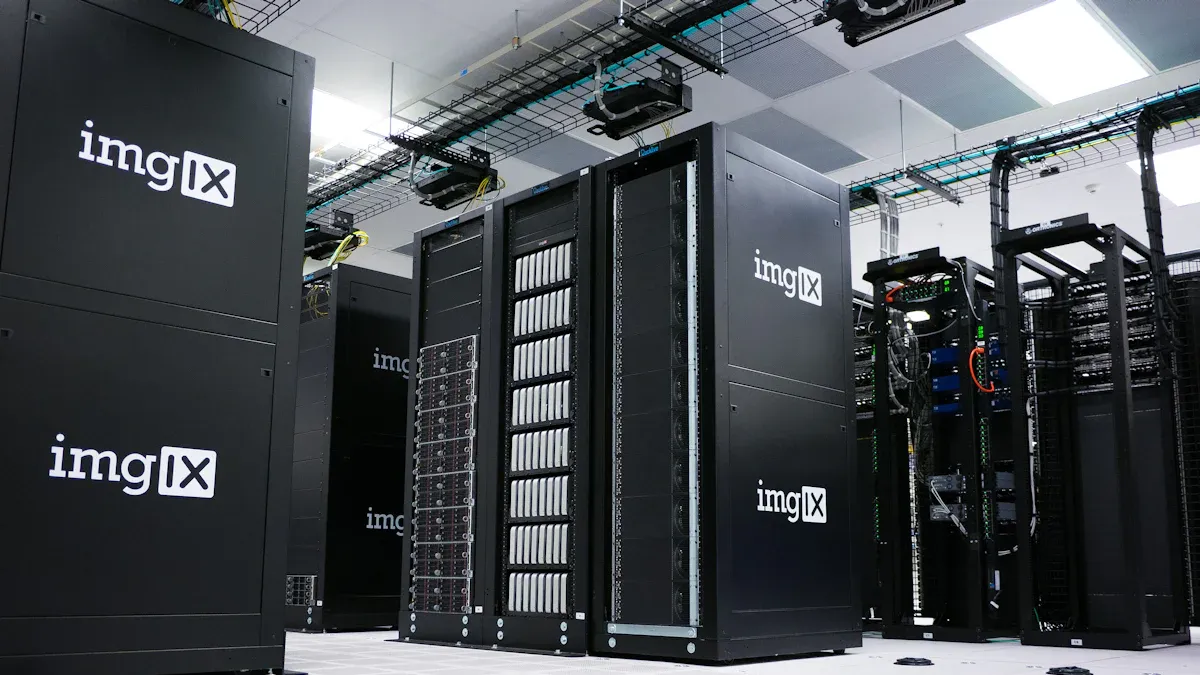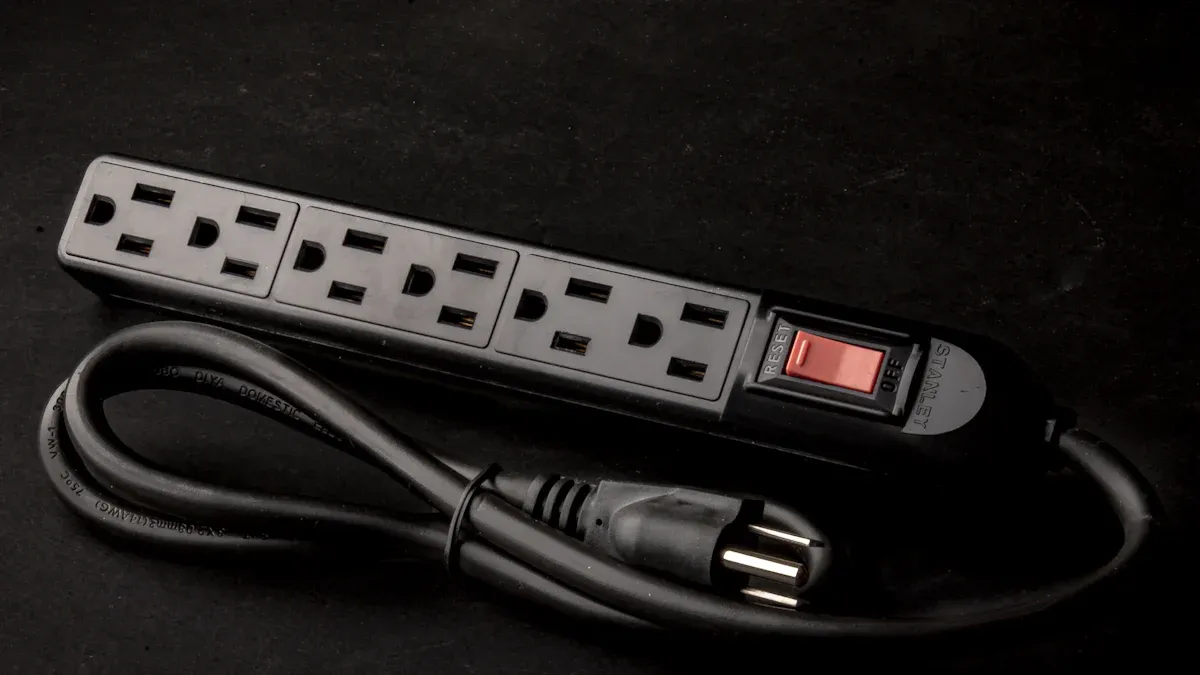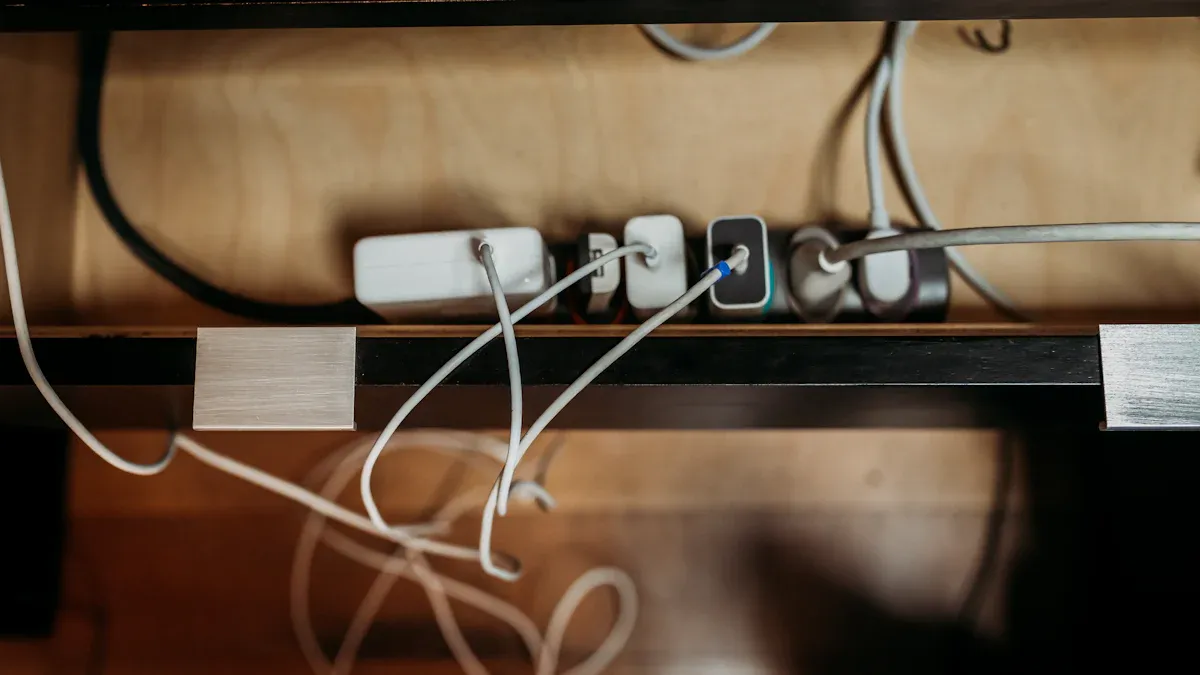
A rack PDU is not merely a power strip; it represents a sophisticated power management solution. Many people mistakenly believe that all power strips provide surge protection or that rack PDUs are exclusive to data centers. In reality, rack PDUs serve various environments, including workshops and high-demand offices, offering advanced features that power strips lack.
Key Takeaways
- A PDU is more than a power strip; it offers advanced features like load balancing and overload protection, making it ideal for high-demand environments.
- Rack PDUs provide real-time monitoring of power usage, helping to prevent overloads and equipment failures, which is crucial in settings like data centers.
- Safety features in PDUs, such as industrial-grade circuit breakers, significantly reduce the risk of electrical fires compared to basic power strips.
Defining PDUs and Power Strips

What is a PDU?
A Power Distribution Unit (PDU) is a device designed to distribute electrical power to multiple devices efficiently. PDUs are essential in environments such as data centers, server rooms, and workshops. They ensure that connected devices receive the appropriate power supply while maintaining safety and efficiency.
Here are some key features of a typical PDU:
| Feature | Description |
|---|---|
| Power Capacity | Refers to the maximum amount of electrical power the PDU can handle, crucial for supporting the electrical load of connected devices. |
| Input and Output Connections | Various options accommodate different power sources and devices, including NEMA, IEC, and twist-lock plugs for input, and NEMA, IEC, and C13/C19 outlets for output. |
| Outlet Types and Configurations | Includes standard and locking outlets, configured in horizontal, vertical, or mixed arrangements to ensure compatibility with device power cords. |
| Monitoring and Management Capabilities | Advanced features for remote monitoring of power usage, load balancing, and control of individual outlets, essential for efficient power management. |
| Redundancy and Fault Tolerance | Built-in features like redundant power sources and automatic transfer switches ensure uninterrupted power supply in critical applications. |
| Mounting Options and Form Factor | Available in various mounting options (rack-mounted, wall-mounted, floor-standing) and form factors (slimline, compact, modular) to suit different installation requirements. |
| Surge Protection and Power Filtering | Built-in capabilities protect connected devices from electrical surges and disturbances, ensuring reliable operation of sensitive equipment. |
What is a Power Strip?
A power strip is a simple device that provides multiple electrical outlets from a single wall socket. It allows users to plug in several devices simultaneously. However, power strips have limitations and specific safety standards.
According to safety regulations, power strips must adhere to the following guidelines:
- OSHA standard 29 CFR 1910.303(b)(2) requires that listed or labeled equipment be installed and used according to the manufacturer’s instructions.
- Power strips are intended for indoor use only and should connect to a permanently installed branch-circuit receptacle outlet.
- They should only power low-powered devices and not high-power loads like space heaters or refrigerators.
- Power strips must not daisy-chain or connect to other relocatable power taps.
- They are not intended for use in high-hazard environments or for permanent installation.
Power strips serve as temporary extensions of a grounding alternating-current branch circuit, as defined by Underwriters Laboratories (UL) standard 1363. The National Electrical Code recognizes power strips as Multioutlet Assemblies in Article 380.
While power strips are convenient, they lack the advanced features and safety mechanisms found in rack PDUs, making them less suitable for high-demand environments.
Key Differences Between PDUs and Power Strips

Functionality
The functionality of PDUs and power strips differs significantly. PDUs excel in power distribution and management, making them suitable for high-demand environments. They provide advanced features such as load balancing and overload protection. In contrast, power strips serve a more basic purpose, allowing users to connect multiple devices to a single outlet without advanced management capabilities.
| Feature | Power Strips | PDUs |
|---|---|---|
| Gauge Ratings | Typically 14 AWG, suitable for medium-duty appliances | Range from 14 AWG to 6 AWG, suitable for various appliances |
| Voltage Ratings | 110V/208V/230V single-phase power | 208V/400V three-phase connections for heavy-duty applications |
| Safety Features | Often include surge protectors | Usually have overload protectors and industrial-grade fuses or MCBs |
Features
PDUs come equipped with features that enhance their usability in demanding settings. They often include:
- Advanced load balancing capabilities.
- Overload protection that cuts off power when a current limit is exceeded.
- Industrial-grade resettable fuses or miniature circuit breakers (MCBs).
Power strips, while convenient, typically lack these advanced features. They may include basic surge protection but do not offer the same level of circuit protection or load management.
- PDUs provide overload protection.
- Power strips typically do not offer such protection.
- Data centers often require separate surge protectors for sensitive equipment.
Applications
The applications of PDUs and power strips vary widely based on their design and functionality. PDUs are ideal for environments such as data centers, server rooms, and industrial settings where reliable power distribution is critical. They support high-capacity loads and ensure efficient power management.
Power strips, on the other hand, find their place in everyday settings. They are perfect for connecting multiple devices like phone chargers, computers, and appliances in homes or offices. Users often choose power strips for their convenience in powering several devices in one location, such as a laptop, printer, and phone charger.
- Power strips are ideal for connecting multiple devices such as phone chargers, computers, and appliances.
- They provide a convenient solution for powering several devices in one location.
- Choosing power strips with built-in circuit breakers enhances safety.
Benefits of Using a Rack PDU
Enhanced Power Management
Rack PDUs provide superior power management compared to traditional power strips. They allow users to monitor energy consumption in real-time, which helps in identifying inefficiencies. This capability enables load balancing, ensuring that power distribution remains even across all connected devices. As a result, rack PDUs can prevent overloads and reduce the risk of equipment failure.
“Advanced rackmount PDUs give you powerful monitoring and control features, helping you track power use and keep your equipment safe.”
Monitoring Capabilities
Monitoring capabilities stand out as one of the most significant advantages of rack PDUs. These units often feature metering that captures metrics such as voltage, current, and active power. This data allows facility managers to make informed decisions about energy use. Additionally, many rack PDUs include alerts for issues like overloads or abnormal temperature changes. Such features facilitate immediate action, minimizing downtime and enhancing operational efficiency.
| Feature | Description |
|---|---|
| Metering | Captures metrics such as voltage, current, active power, and energy, helping to monitor power usage. |
| Switching | Allows control of individual outlets for power cycling and includes power sequencing delays. |
| Environmental Monitoring | Supports sensors for temperature and humidity to ensure optimal conditions without separate solutions. |
Safety Features
Safety features in rack PDUs significantly reduce the risk of electrical fires. Unlike basic power strips, rack PDUs often include industrial-grade resettable circuit breakers that disconnect power during overloads. They also monitor temperature, shutting down if thresholds are exceeded. This proactive approach to safety ensures that equipment remains protected, making rack PDUs a reliable choice for critical environments.
| Feature | PDUs | Power Strips |
|---|---|---|
| Overload Protection | Industrial-grade resettable circuit breakers or MCBs that disconnect power on overload | Often lack robust overload protection; may have basic fuses |
| Thermal Protection | Built-in systems that monitor temperature and shut down if thresholds are exceeded | May lack advanced thermal monitoring capabilities; basic thermal protection in some models |
A PDU offers advanced features and functionalities that surpass those of a power strip. Key benefits include:
- Remote monitoring and management capabilities.
- Enhanced safety features for high-demand environments.
- Scalability for growing power needs.
In contrast, power strips suit simpler setups, such as home offices. Choosing the right solution depends on specific application requirements.
| Feature | Power Strip | PDU |
|---|---|---|
| Use | General | IT/data center |
| Safety | Basic | Advanced |
| Monitoring | None | Remote, detailed |
Investing in a PDU ensures reliable power management across various settings.
FAQ
What types of environments benefit from using a PDU?
PDUs are ideal for data centers, server rooms, workshops, and high-demand offices where reliable power distribution is crucial.
Can I use a PDU for home appliances?
While PDUs can power home appliances, they are designed for high-capacity loads and may not be necessary for typical household use.
How do I choose the right PDU for my needs?
Consider factors like power capacity, outlet types, monitoring features, and installation requirements to select the appropriate PDU for your environment.
Post time: Sep-19-2025





